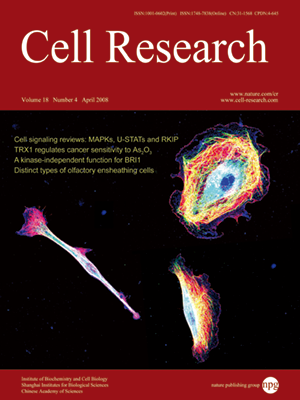
Volume 18, No 4, Apr 2008
ISSN: 1001-0602
EISSN: 1748-7838 2018
impact factor 17.848*
(Clarivate Analytics, 2019)
Volume 18 Issue 4, April 2008: 458-471
ORIGINAL ARTICLES
Redox status of thioredoxin-1 (TRX1) determines the sensitivity of human liver carcinoma cells (HepG2) to arsenic trioxide-induced cell death
Changhai Tian1, Ping Gao1, Yanhua Zheng3, Wen Yue1, Xiaohui Wang1, Haijing Jin1 and Quan Chen1,2
1The Laboratory of Apoptosis and Cancer Biology, State Key Laboratory of Biomembrane and Membrane Biotechnology, Institute of Zoology, The Graduate School of Chinese Academy of Sciences, Chinese Academy of Sciences, Datun Rd, Chao Yang District, Beijing 100101, China
2College of Life Sciences, Nan Kai University, Tianjin 300071, China
3Department of Neuro-Oncology, MD Anderson Cancer Center, 1515 Holcombe Blvd., Houston, TX 77030, USA
Correspondence: Quan Chen(chenq@ioz.ac.cn)
Intracellular redox homeostasis plays a critical role in determining tumor cells' sensitivity to drug-induced apoptosis. Here we investigated the role of thioredoxin-1 (TRX1), a key component of redox regulation, in arsenic trioxide (As
2O
3)-induced apoptosis. Over-expression of wild-type TRX1 in HepG
2 cells led to the inhibition of As
2O
3-induced cytochrome c (cyto c) release, caspase activation and apoptosis, and down-regulation of TRX1 expression by RNAi sensitized HepG
2 cells to As
2O
3-induced apoptosis. Interestingly, mutation of the active site of TRX1 from Cys
32/35 to Ser
32/35 converted this molecule from an apoptotic protector to an apoptotic promoter. In an effort to understand the mechanisms of this conversion, we used isolated mitochondria from mouse liver and found that recombinant wild-type TRX1 could protect mitochondria from the apoptotic changes. In contrast, the mutant form of TRX1 alone elicited mitochondria-related apoptotic changes, including the mitochondrial permeability transition pore (mPTP) opening, loss of mitochondrial membrane potential, and cyto c release from mitochondria. These apoptotic effects were inhibited by cyclosporine A (CsA), indicating that mutant TRX1 targeted to mPTP. Alteration of TRX1 from its reduced form to oxidized form
in vivo by 2,4-dinitrochlorobenzene (DNCB), a specific inhibitor of TRX reductase, also sensitized HepG
2 cells to As
2O
3-induced apoptosis. These data suggest that TRX1 plays a central role in regulating apoptosis by blocking cyto c release, and inactivation of TRX1 by either mutation or oxidization of the active site cysteines may sensitize tumor cells to As
2O
3-induced apoptosis.
Cell Research (2008) 18:458-471. doi: 10.1038/cr.2007.112; published online 24 December 2007
FULL TEXT | PDF
Browse 1897


